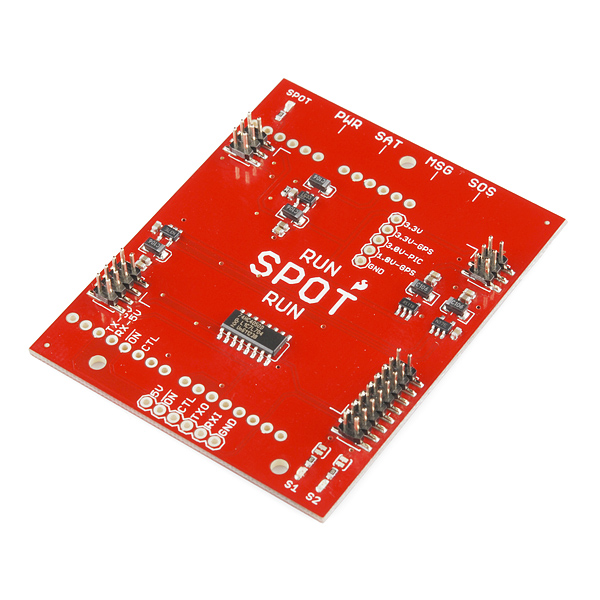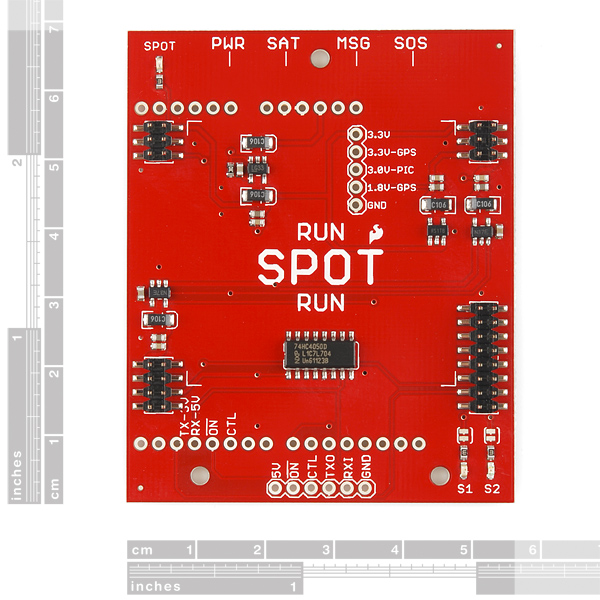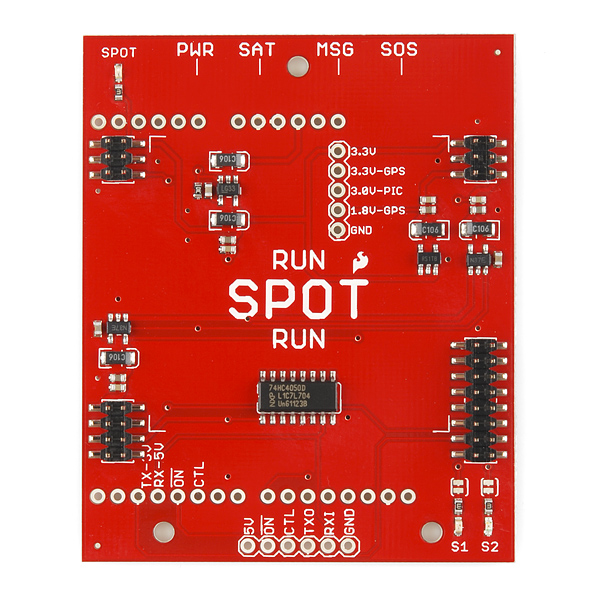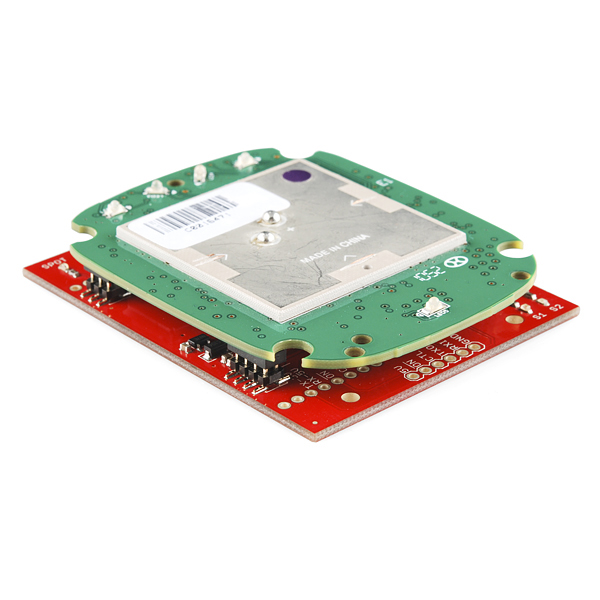SatUplink Shield
Replacement: None. We're no longer building this product. This page is for reference only.
SPOT is a service that makes adventures off the beaten path a little safer by providing a way to check in, send "I'm ok" messages or call for help via satellite. That's all very useful if you're going out into the wild beyond the reach of cellular and WiFi, but what if your Arduino is going and leaving you behind in civilization? Wouldn't it be nice if it could take advantage of this technology to send you an e-mail or text message from the middle of nowhere?
This shield allows your Arduino to access the awesome satellite communication technology in the SPOT Connect module. Simply dismantle your SPOT Connect device and carefully pull it apart like an Oreo cookie, the remaining headers will mate with the headers on the SatUplink Shield allowing your Arduino to talk to the heavens and broadcast short text messages (41 characters) to and from almost anywhere!
SPOT is a subscription service, so it is going to cost you $99/year to get up and running plus $0.10 per message: not bad for getting your messages to space and back.
This shield does not include the SPOT Connect device, you'll have to furnish that yourself. Checkout the Run SPOT Run tutorial to see how to open up your SPOT Connect and how it works.
SatUplink Shield Product Help and Resources
Comments
Looking for answers to technical questions?
We welcome your comments and suggestions below. However, if you are looking for solutions to technical questions please see our Technical Assistance page.
Customer Reviews
No reviews yet.






Anybody have one of these boards they're not using? I'd love to try this project!
Oh god, I love you guys.
A quick note about the service: The normal service includes the ability to send prewritten messages. If you want to send data or any other custom message from the module a trial of the custom message sending service is included however after 5 messages you will have to buy messages at 50 cents per message or you can prepay for around 10 to 30 cents per message.
Just thought I'd put that out there for those that have plans to use this device.
Source
So let me get this straight, I can go with 10cents/message anywhere on the planet (SPOT) or I can go with 10cents/message within cell phone range (T-Mobile prepaid)?
Thanks for the correction. I've updated the product description.
I was able to send 7 messages before they stopped reporting the messages. Your mileage may vary. I could still see the unit's long/lat on the SPOT site but the 41 character message was not shown.
Does anyone know if this will this work with the SPOT II receiver?
As a Merchant Mariner by profession, this interest me for obvious reasons. I look forward to the communities help on making this work.
-Thanks
Edit For what it's worth, I looked into it further and the DeLorme (inReach)/Iridium system better suits my needs with two way data, better coverage and cheaper TX rates.
I was wondering if someone could tell me why this product was retired. Is it simply because of a lack of interest? Or, are there technical or legal problems with it? Basically, I'm wondering if it's worth working from the Eagle files provided for a project I'm doing.
2 main reasons. First is that the sales were not that good. But more importantly the actual SPOT module kept changing. I'm not sure the final end user product changed, but the PCB design and test points we were using did. It wasn't worth it to try to keep up (see point number 1).
Hey Nate, this thing has been great, thanks! I have posted a comment on your SPOT tutorial page ( http://www.sparkfun.com/tutorials/340 ) that describes how to send "predefined messages". These are FREE! Also, I recommend replacing the MIC5219 for the MSP/General supply with a 1A regulator such as the LP38692. The SPOT can pull more than 500mA during transmit, so the 5219 drops out sometimes and is generally unreliable.
If you are having trouble, make sure the voltage to the satellite transmitter is good, that is critical and the reason G* spec's lithium primary cells, they maintain their cell voltage 'till near end-of-life. if you've got an alt. supply, make sure it has low source impedance, no voltage sag while radiating.
I could not get the code at https://github.com/sparkfun/Run-SPOT-Run to reliably work for me but I have written some alternative code which has been working well. You can find it at https://github.com/fluffy/SprayWind/blob/master/Arduino/WindSat/WindSat.ino It's open source (BSD) and the part for controlling the SPOT is set up to be yanked and and used as an Arduino library. I'll set it up as a stand along library if others find that useful. I'm using it to send data from a remote weather station where there is not cellular coverage or other way to get the information back.
I used this in a project to meassure the wind. An arduino counts the pulses from the anemometer to compute a wind speed. It then uses a Spot Connect device to transmit this wind and temperature information to the web via the globalstar satalite system. This generates an email that drives a django based website. All the code is open source at https://github.com/fluffy/SprayWind and I look forward to hearing about what other people end up doing with this system.
This project was started as an little amusement to do over the holidays and provide information about the weather conditioins at Spray Lakes in Alberta Canada for the the folks that snowkite there. You can see the current data from this station at spraywind.com.
Some documentation of the design can be found at http://doc.spraywind.com/doc/design.html
So, a message sent from this shield goes to the SPOT server, is it ? Is there a device that would allow me to beam up a message and receive at an IP address of my choice ?
First, thanks so much Nate! I just put this project together, cracked open a SPOT Connect, and it worked right out of the box. Sweet. Question for you ... It's my first time using an Arduino (usually I live in PIC-land). The Arduino w/SPOT seems to work just fine when connected via USB and the serial monitor open, but as soon as I try to run it stand-alone using batteries, it doesn't. SPOT powers up, tries to send a message ... no joy. Is there any reason this shouldn't work when not tethered to a PC?
Sort of like the ham radio APRS system except with huge limitations and a $ub$cription.
KC6ETE-9 (google it)
My company makes a similar product (Part of the "Cerberus" system) which uses the Iridium network, so it can send AND RECEIVE text data over satellite, and connects to your smartphone via bluetooth. Our API is completely open so you can write your own Android/iOS apps or embedded code to send whatever type of information you like. Information is here if anyone is interested:
http://cerberus.briartek.com/
Do you use the 9602 in yours?
It would be fun to play with and hack, but the the core Iridium components and service is only provided thru vendors as I am sure you are well aware of and the prices seem to vary greatly between them.
an true eletronic enginer prefer to disassemble and reverse-engginering an device than just conect it on bluetooth and send commands. =P
Hmmm. "Run SPOT Run" seems to me as if the board is telling the module to run for its life, coz it is gonna get hacked. /me likes it.
Does anyone know what the 41 characters are limited to? Is it ASCII-7? Any 328 bits? Anything that could pass off as UTF-16?
I had to go looking for it, save others the trouble
This system uses globalstar
http://www.marinesatellitesystems.com/index.php?page_id=801
Hold it! As far as I know, you cannot get your messages to space "and back", because the SPOT Connect only sends data, right?
It comes back just not to the sending node. It would be pretty useless to have the terminating node in space unless it was at the ISS.
Maybe I wasn't too clear. I meant that with the SPOT Connect you can only send but not receive data, please correct me if I'm wrong.
Technically the SPOT Connect receives signals from the GPS network. But for what you are talking about, no, the SPOT cannot receive commands or transmissions from you at home. It only transmits.
Too cool! Nate, how on earth did you reverse engineer that!?
It's what geeks do over Christmas. In between times hanging out with the family, I was giddily pouring over serial logs! Tutorial is up over here: http://www.sparkfun.com/tutorials/340
Sweet thanks. You're right- that thing really was designed to be hacked